Do you need the perfect baritone? Look no further than the Yamaha YBH-301S Series, which is more intended for younger students. I will walk you through the wonderful world of baritone horns and then give a guided tour of some of the best ones on the market.
The baritone is one of my favorite instruments. Having played it in the high school concert band, I loved the feel of its nine feet of tubing in my hands and the ability to switch between treble and bass clef at a whim. For this article, I delved into my memories of playing this beautiful instrument, but I didn’t stop there.
I did twenty hours of research on baritone specifications and the choosing of the proper baritone, then thirty more hours researching the best baritones on the market. Doing this made me want to play the instrument all over again!
What the Baritone is Not
Before diving into the specifications of the baritone horn, one thing needs to be cleared up: this is not a euphonium. There are three main myths people hold about the baritone horn and the euphonium. These myths were caused by the manufacturers.
Valve – People believe that the baritone is the three-valve instrument and the euphonium the four-valve. However, there are both four-valve baritones and three-valve euphoniums.
Bell – People say the baritone has a forward-facing bell while the euphonium’s is upright. This is also not always the case.
Difficulty – People believe that the baritone is the easy instrument and the euphonium the harder one. They are not harder or easier, just different.
Now that the basic myths have been put to rest, consider what is actually different between the baritone horn and euphonium:
Bore shape – As Andy McKeown states (“Conical v. Cylindrical Bore- What’s the Difference?”) the bore of an instrument, the diameter of the tubing, can be either conical or cylindrical in nature.
Conical bores start smaller and gradually flare out over the length of the instrument. These types of bores are found in cornets, French horns, tubas and euphoniums and produce a darker, richer sound.
Cylindrical bores, on the other hand, maintain the same diameter until the bell piece, when it finally flares out. These types of bores cause the sound to be lighter and brighter and are found in such instruments as trumpets, trombones, and baritones.
Size – A second difference between the baritone and euphonium is found not in the tubing, but in the overall size of the instrument. The baritone horn is more tightly wrapped than the euphonium and has a smaller bell. This makes the instrument more compact, thus easier to carry and handle.
Specifications of the Baritone Horn
Now that you know what the baritone horn is not, let’s look at what it is. The baritone horn is a member of the brass family, an instrument into which you buzz with your lips.
With nine feet of tubing, the baritone horn plays the same notes as the trombone and even has the same mouthpiece, but Valves replace slides as the main way to change notes.
Valves
Speaking of valves, there are usually three piston-style valves on a baritone horn. Each of these lowers or raises the sound by one half-note.
The fingering on a baritone is very similar to that of a trumpet, so many players of this other instrument can sit down with the baritone horn and play a decent melody. The fingerings are similar, too, to that of the tuba, with many hopeful tuba players starting on the baritone for the first few years of their music career.
Note that earlier I said that there are usually three valves. This instrument can also have a fourth, which will, according to Instrumental Savings (Baritone Buying Guide), allow the pitch of the instrument to sink even lower and provide alternative fingerings that may suit the player better, depending on their needs.
Four-valve baritones are, however, rare to find and because of the complication they add, they are not suggested as suitable instruments for the beginner.
Bell Style
The bell flares up at the end of the baritone to help amplify the sound. There are two styles of bell for the baritone horn: fixed-upright and bell-front.
As you likely guessed, fixed-upright bells are fixed in an upright position; this means they face the ceiling. A fixed-upright bell, according to Instrumental Savings, makes the baritone easier to balance as you play and produces a warmer, more pleasing sound.
However, there are benefits to having a bell-front style of bell, which is one that is turned to face in the same direction as the player. While this forward-facing bell makes the instrument more difficult to balance, it is much easier to rig a microphone to catch the sound of a bell-front baritone.
This style of bell also projects the sound of the instrument further and stands up to the test of time much better if used in an outside setting. Imagine, if you would, what would happen to a baritone with each bell style if it started raining.
The baritone with the fixed-upright bell would be flooded with rain water, while the one with the bell-front style would be fine. There is also the marching baritone, but I will discuss that at a later point in this article.
How Much Does the Material Really Matter?
What your baritone horn is made from is a very important question to determine before purchasing the instrument. There are four materials that a baritone horn can be made from: yellow brass, gold brass, red or rose brass, and nickel silver. There are a few differences between the four:
Material Composition Appearance Durability Sound
Yellow Brass 70% copper, 30% zinc: Highly susceptible to corrosion cutting and direct, bright
Gold Brass 85% copper, 15% zinc: slightly darker than yellow some susceptibility to corrosion, less than yellow broad, full, darker
Rose Brass 90% copper, 10% zinc: Reddish hue Protects against red rot warmer, mellow, doesn’t project as well as other brass
Nickel-silver 60% copper, 20% zinc, 20% nickel: Silvery hue Highly durable, Good balance between bright and dark tones
Lacquer or Silver-Plate?
You will commonly find one of two finishes on a brass instrument such as the baritone horn: lacquer or silver-plating. According to Instrumental savings, lacquer makes the instrument deeper and darker in the low notes and is more affordable than silver-plate.
For the cost-conscious beginner, lacquer is the way to go. It can come in many colors, but clear and gold are the most common. Silver-plate, however, is better suited to the more advanced players because of its cost and maintenance requirements.
Silver-plate requires a lot of polishing to keep its shiny silver appearance. However, silver-plate gives the brass instrument a warmer tone that many players like.
Bore Size
Bore diameter plays a big role in the sound of a baritone horn. Instrumental Savings notes that bore sizes are measured in thousandths of an inch and range from 0.500 to 0.562.
The smaller the bore size, the more resistance it provides and the better it is for a beginning student. Large bore diameters mean lower resistance, making them much more suitable to advanced players.
Variations
Up until now, I have talked about the standard, single bell concert baritone. However, there is a variation that warrants mentioning.
This is the marching baritone. Specifically designed for marching band and drum-and-bugle corps, the marching baritone is designed differently from the concert baritone.
It has the standard three piston-style valves and remains in the tone of B flat, but looks more like an overlarge trumpet. This design makes the instrument easier to carry while marching.
Level Models
Baritones come in three level models: student, intermediate (or step-up), and professional:
Student – are intended for beginners or those who are not sure if baritone horn is their preferred instrument. These typically are the bare bones: non-compensation, three valves, and smaller bore diameter. These are not your high-quality professional baritones, but they are durable and very affordable.
Intermediate – step-up baritones have more options available for the musician who has played for at least two to three years. These instruments may have a fourth valve, be compensating, and often have the upgraded silver-plate. These added options and better workmanship make these baritones more expensive.
Professional – are not for your son or daughter who have been playing baritone for a few years, but rather for musicians who have been playing for many years and have a full commitment to the instrument. Often hand-crafted, professional baritones generally have larger bore diameters and are compensating. They can also be silver-plated for better sound and can be rather expensive.
What to Look For
A lot of buying a baritone horn is subjective to your personal preferences, but there are a few things that you can look for when purchasing one. The most important of these is the sound quality.
Tone – Before purchasing the baritone, do your research and learn what the tone of the instrument is like. Listen to a sound clip if it is available or look for the instrument on YouTube. Sound quality is very subjective to a point; if it sounds good to you, it may be that its sound quality is what you are looking for.
Responsiveness – If you cannot get your hands on the instrument, this is a tough one to judge. However, talking to the manufacturer and vendor may give you a good idea of the responsiveness, such as how fast the pistons press down, how quickly the instrument can switch from note to note, and how well the baritone can reach the full extension of the octaves.
Durability – Many factors, as stated earlier, can affect the durability of the instrument. The main factors are the craftsmanship and metal of the baritone.
Price – If you are looking for a beginning student’s first horn, you will not want to buy a $5,000 instrument. Likewise, be careful of baritones that are very low in price. These are often cheaply made and do not play well.
Our Top Pick: Yamaha YBH-301S Series
This is a great instrument for bands and orchestras with great responsiveness and projection. A silver-plated yellow brass baritone horn, this instrument has a bright, vibrant sound that stands out in bands and orchestras.
Intended for the student, it has a .504 bore and an 8.75-inch fixed-upright bell. Lightweight and compact, this is the perfect baritone for younger players. The three valves are top-action; nickel-plate alloy piston-style with yellow brass casings, making them durable but practical.
The bell of the instrument is small, just over the width of my hand, and the tubing is compacted to fit behind the valves. It has a small tenor trombone-sized shank and a main tuning slide that may not work effectively. I found it unresponsive and noisy, and the felts may need replacing. Despite these issues, it is still suitable for intermediate-level, high school, and even some professional players.
It has a bright sound due to its small construction and cylindrical bore. High notes are not necessarily easier to play on this instrument compared to a euphonium, but the difference is in how well the high overtones can be heard and the brightness of the sound. It excels in march settings (where a brighter sound is desired), and fast runs feel good on this smaller, more nimble instrument.
The pedal B-flat is my favorite note on this instrument and the pedal range is good, but not the best. The high and low octaves are also present, but the low E natural may require some slide pulling.
Non-compensating, it nonetheless has a consistent, vibrant sound and easy tone production. This instrument also features a gold brass leadpipe, which helps prevent red rot.
With the five-year limited warranty that comes with all Yamaha musical instruments, this baritone horn is also a good value. It comes with a hard shell case and a mouthpiece.
King 625/627 Diplomat

Credit: Musician’s Friend
Another great baritone horn is a professional model baritone horn – the King Diplomat comes with a .562 bore and an 11-inch bell diameter. It is available in either a bell-front (625) or fixed-upright (627) position.
Made of yellow brass, another great feature is that it is available in lacquer or silver-plate, so you can decide whether you want a less expensive or better-sounding instrument.
With three front-action nickel-plated piston valves, you will get a more comfortable hold on this baritone, while also getting durability where it counts the most. It has a non-compensating system, but with a generously smooth sound.
Pull rings on the first two slides make tuning a breeze and the notes are very responsive. With a plastic shell case and mouthpiece, this baritone horn is a steal.
Amati ABH 321 Series

Credit: AMATI
A lacquered yellow brass, this baritone horn has a red brass leadpipe and nickel-silver trimmings. Intended for the intermediate player, it is a lightweight and compact ¾-size baritone.
Three top-action stainless steel valves are placed in a compact design, and it has a small bore diameter of just .490. In addition, the bell, which is fixed-upright, is a small 8.7-inches in diameter.
Easy to maneuver and even easier to carry, this instrument has a beautiful, mellow tone.
Besson BE2056 Prestige Series

Credit: Musician’s Friend
Made of yellow brass, the Besson BE2056 Prestige Series Baritone horn can be purchased with either a lacquer or silver-plate finish.
An intermediate model, it has a .543 bore and a 9.5-inch bell diameter. Its four valves are stainless steel and laid out with three on top and one on the side, making a very traditional appearance.
With a consistent, vibrant sound and easy tone production, this is easily the most expensive of the baritones described in this article, costing almost $8000.
Jupiter JBR730 Standard Series

Credit: JUPITER
Here is another ¾-size baritone horn, this time with a .531 bore that would be a more traditional diameter. An intermediate model with a compensating system, the Jupiter JBR730 Standard Series baritone looks and plays wonderfully.
An intermediate model with a compensating system, the Jupiter JBR730 Standard Series baritone looks and plays wonderfully. It has a yellow brass bell, red brass leadpipe, nickel-plated slides, and three stainless steel piston valves.
Even with the fixed-upright bell position, this Jupiter baritone has superb projection. Coming with a case and mouthpiece, it costs just a little more than $2000.
Yamaha YBH-621S

Credit: Yamaha Corporation
Another option if you like Yamaha, the Yamaha YBH-621S baritone horn is a silver-plated yellow brass instrument with a compensating system.
The Monel alloy of the four pistons gives it an extra durability and the valves are in the traditional layout of three on top, one on the side. The valve casings and mouthpiece are all gold brass, which gives this instrument more durability points. With a .504 bore and 8.375-inch fixed-upright bell, it has a great sound and easy tone production.
Like all Yamaha instruments, this baritone horn comes with a plastic shell case, mouthpiece, and five-year limited warranty. Averaging out at $4500, this instrument is quite a deal for any band or orchestra player.
Whatever your needs, whatever your desires, there is sure to be a baritone horn for you in this article. The instruments presented run the distance from three-valve to four and beginner to professional.
Just keep in mind that you should look at the sound quality, responsiveness, durability, and price before all the snazzy features. However, you cannot go wrong with one of these gems!
To recap, here’s the full competition:










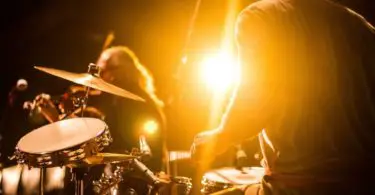
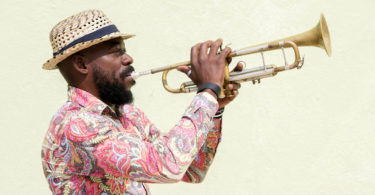
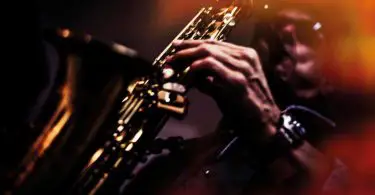
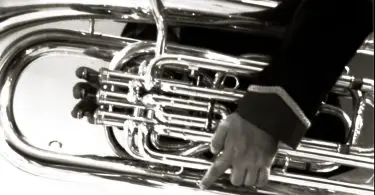
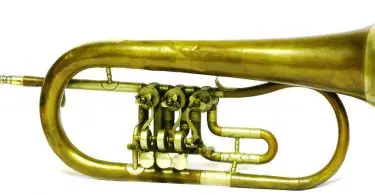
Not too much clarity on the best ones for Marching. A little review, from my opinion:
Yamaha: Only one with a large shank mouthpiece receiver. Easy to control in the lower register. Overall good tone. I do not feel they equal the projection of other available. Often the baritone of choice for high school marching.
King: Light-weight baritone all-arounder. Tone suffers and stuffy in the low register. Intonation’s not that solid. Used by high school marching bands mostly due to low price and being light.
Dynasty: Great tone and projection. May have intonation problems, and the low register isn’t great. Also
common in high school marching bands.
Kanstul: I like this one best. Beautiful tone, projects well, and blends as needed into the ensemble. Excellent intonation. Too bad not many high schools use them as they’re nearly as heavy as marching euphoniums and cost.
If your price conscious and can’t go Kanstul, depends what you prefer: If you like tone over low range go for the dynasty. If the large shank receiver and overall satisfactory is more important, the yamaha. My two cents!
Jupiter 730 is not a compensating horn, I play one in a street band, while not as warm sounding as my older Conn bari, it’s a lot lighter to handle being in a mobile band and projects really well. I can also get to higher register better, like on a trombone. I’ve played a Yamaha 301, the Jupiter sounds clearer and less stuffy than the Yamaha, it’s better value but the metal can dent easy on the Jupiter. (Yamaha made better but didnt sound better to me for outdoor playing) jupiter price varies widely online, so do some research and contact music shops as some will price match. It would be an excellent starting instrument as the intonation is good, and a student can grow with it, sound wise, never buy the cheap models like Lark from China, or India (selling on eBay) Lark had terrible tuning especially the 3rd valve.
I really like this little Jupiter, also an option as a travel practice horn, ‘mini’ tubas are a bit of a gimmick